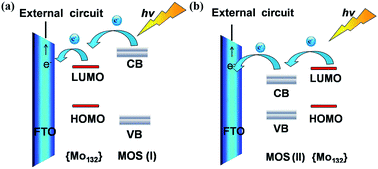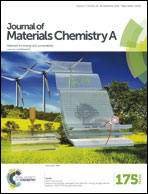Keplerate-type polyoxometalate/semiconductor composite electrodes with light-enhanced conductivity towards highly efficient photoelectronic devices†
Abstract
Metal oxide semiconductor (MOS) photoelectrodes hold great promise for new energy and environmental applications, from water splitting to photoelectronic devices. Here, we show an efficient polyoxometalate assistance strategy for the design and fabrication of MOS composite photoelectrodes with light enhanced conductivity. Four types of MOS based photoelectrodes were fabricated by a simple wet chemistry method through bounding TiO2, SnO2, WO3, and ZnO with keplerate-type polyoxometalate (NH4)42[MoVI72MoV60O372(CH3COO)30(H2O)72] ({Mo132}), respectively. In these photoelectrodes, {Mo132} may act as a photo-induced electron acceptor/donor to accelerate electron transfer and then improve their conductivity efficiently. We further demonstrated that the 5% {Mo132}/TiO2 modified photoanode, in dye-sensitized solar cells (DSSCs), exhibits a power conversion efficiency (PCE) of 7.94% (31% improvement compared with that of the TiO2-based cell (6.06%)).


 Please wait while we load your content...
Please wait while we load your content...